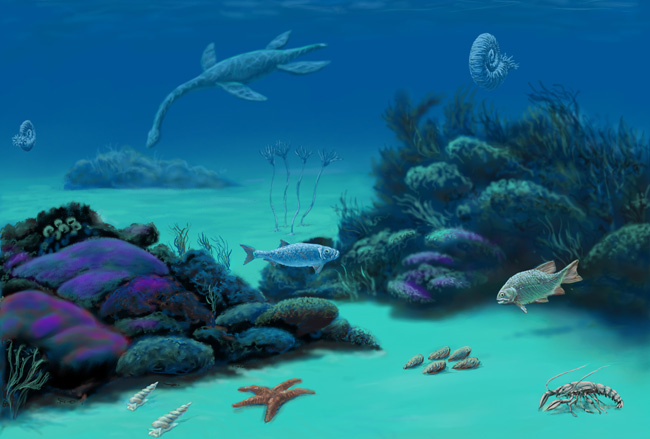Be smart, be an EarthCacher - geology rulez! ;)

Acknowledgment: Monika Krzeczyńska MSc / Polish Geological Institute-National Research Institute
Podziękowanie: mgr Monika Krzeczyńska / Państwowy Instytut Geologiczny-Państwowy Instytut Badawczy
Ten EarthCache jest dedykowany mgr Pawłowi Woźniakowi z Państwowego Instytutu Geologicznego-Państwowego Instytutu Badawczego. Paweł, za Twój humor, niezłomnego ducha i big adventure! :D
Monika & Leo

Wybierz się na wędrówkę w czasie - przenieś się do czasów, gdy większość obszaru Polski zatopiona była pod wodami tętniącego życiem, ciepłego morza jurajskiego sprzed 160-150 mln lat temu! Znajdujesz się właśnie na dnie jurajskiego morza!

Long long time ago... / graphic: PGI-PRI
Stoisz na szczycie rozległej budowli utworzonej przez zamieszkujące najgłębsze strefy dna gąbki krzemionkowe oraz towarzyszące im sinice, zwanej biohermą. Ponad Tobą ponad 50 m słupa wody. Wokół Ciebie w toni przepływają ławice belemnitów i niewielkie grupy ryb. Nagle z ciemności wyłania się potężny drapieżnik - ichtiozaur! Ten 2 metrowej długości gad morski poluje na władców jurajskiego morza - amonity, głowonogi, których ogromna większość populacji wymarła wraz z dinozaurami.
 Aaaale widooook! / photos & background photo: hanbei
Aaaale widooook! / photos & background photo: hanbei
Wokół rozciąga się rozległy krajobraz morski: pełna życia głębia morska z wyraźnie zarysowującymi się na horyzoncie innymi budowlami biohermalnymi z których w przyszłości powstaną twarde, odporne na wietrzenie wapienie skaliste. U stóp biohermy gromadzą się grubsze i drobniejsze osady węglanowe, opadające z toni oraz zsuwające się ze stoków wzniesienia szczątki organiczne. Powstaną z nich kiedyś wapienie i margliste skały uławicone bogate w skamieniałości.

- Paweł, chodzi o to, żeby coś przeżyć... (Monika)
- Przyżyć? Przeżycie to jest jak w Sosnowcu zjesz sobie płucka w barze... Chyba was powaliło! (Paweł)
photos & śmiech: hanbei
UWAGA: szlak turystyczny, jaki tu podobno istnieje(!), jest kompletnie zarośnięty. Najlepiej iść na azymut, inaczej będziecie w drodze jak my, dwie i pół godziny. Przy dobrej pogodzie widok z koordów wynagradza wszystko! No i warto mieć kogoś, kto traci cierpliwość do tej mordęgi ale nigdy dobrego humoru - my mieliśmy Pawła Woźniaka i zabawa była przednia ;))
Odpowiedzi proszę wysyłać za pomocą mojego profilu. Nie trzeba czekać na moją odpowiedź, można od razu logować. Jeśli coś będzie nie tak, zgłoszę się sam. Pamiętajcie proszę, że logi bez podesłanych odpowiedzi będą kasowane.
ZADANIA
- Wróćmy do naszej rzeczywistości - rok 2015, holocen! Jedno ze wzgórz biohermalnych - w postaci podłużnego wzniesienia zauważysz dokładnie w kierunku południowym (spoiler pomocniczy). Zidentyfikuj je ;)
- Jakie dowody znajdziesz w tym miejscu na fakt, że wzgórze, na którym stoisz jest wzgórzem biohermalnym (waypoint)?
- Jakie jeszcze gady morskie żyły wówczas w tych wodach?
- Zadanie opcjonalne: panoramicznie można się tu doprawdy wyżyć ;)

Gorzkowskie Mountains
This EarthCache is dedicated to MSc Paweł Woźniak from Polish Geological Institute-National Research Institute.
Paweł, it’s because of your humor, great spirit and this big adventure!
Travel to the past - to the time when most of Poland was under warm and full of live Jurassic sea - some 160-150 millions of years ago. You are right on the seafloor! You are standing on top of wide structure made by sponges that lived in the deepest parts of the sea and cyanobacteria that companied them. This structure is called bioherm. Above you is a 150 m of water. All around you, in water, swim groups of belemnites and small fishes. Suddenly, from the darkness a huge predator appears - ichtyosaurus! This 2 meter long marine reptile is hunting for the rulers of Jurassic seas - ammonites - cephalopods that become extinct together with dinosaurs. All around you can see a vast marine view: full of life sea depths, with bioherms clearly visible at the horizon. In future they will become the hard, resistant to weathering rocky limestone. At the foot of the bioherm, coarser and finer carbonate sediments are deposited, that are made of material that sank through water column or organic remains that fell down from the slope of the elevation. These are the precursors to carbonate and marl laminated rocks that are rich in fossils.
NOTE: the path that supposedly (!) exist there is completely overgrown. It’s best to just use azimuth - if not you will be going like us - two and half hours. When the weather is nice, the view from the coordinates will be worth any hardships! And it’s good to have someone who may lose the patience but never a good mood. We had Paweł Woźniak and it was a great fun!
You can send answers via my profile. You do not need to wait for my answer, you can log instantly. If something is wrong I will contact you myself. Please remember that logs without answers will be deleted.
TASKS
- Let's get back to our reality - 2015, Holocene! One of the biohermal hills - in the form of an elongated elevation - you will notice exactly in the south direction (spoiler). Identify it ;)
- What evidence can be found in this place that proves the fact that the hill on which you are standing is a biogermal hill (waypoint)?
- What other marine reptiles lived at that time in these waters?
- Optional: make a panorama! ;)
